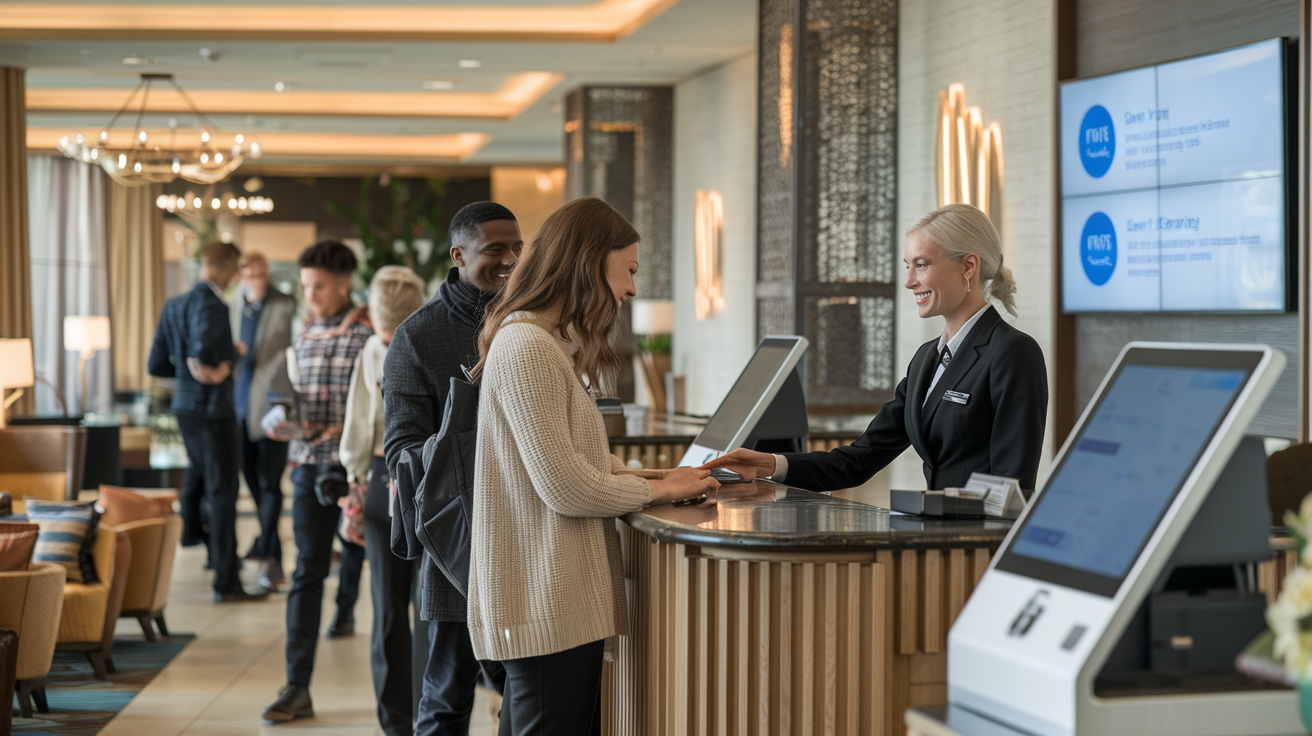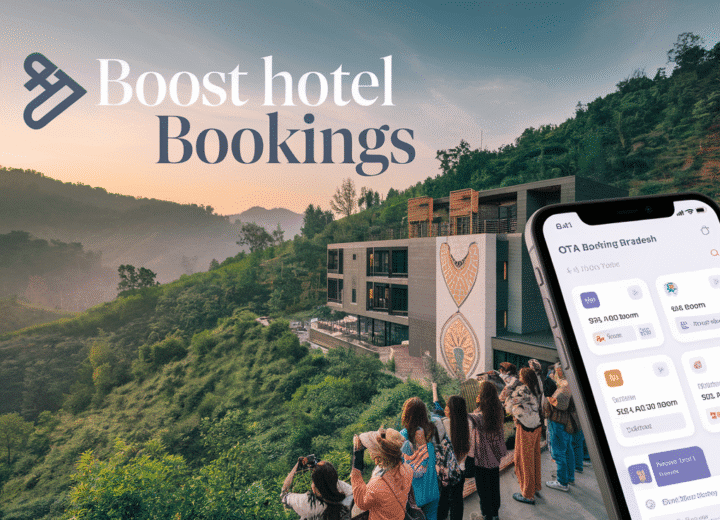
Mastering OTA Management: Strategies to Boost Hotel Bookings and Revenue
Are you struggling to navigate the complex world of online travel agencies (OTAs) and maximize your hotel’s bookings? 🏨💻 In today’s digital age, mastering OTA management is no longer a luxury—it’s a necessity for hoteliers looking to stay competitive and boost their revenue.
With the ever-changing landscape of online bookings, it’s easy to feel overwhelmed by the sheer number of platforms, strategies, and tools available. But fear not! This comprehensive guide will walk you through 7 key strategies to help you dominate the OTA game and take your hotel’s performance to new heights. From optimizing your listings to implementing dynamic pricing, we’ll cover everything you need to know to become an OTA management maestro. 🎯💪
Get ready to unlock the secrets of successful OTA management as we dive into understanding the OTA landscape, maximizing channel management, enhancing guest experiences, and leveraging analytics for data-driven decisions. By the end of this post, you’ll be equipped with the knowledge and tools to boost your hotel bookings, increase revenue, and strike the perfect balance between OTA and direct reservations. Let’s get started on your journey to OTA mastery! 🚀📈
Understanding OTA Landscape

Key players in the OTA market
The OTA landscape is dominated by several major players that have revolutionized the way travelers book accommodations. Here’s a breakdown of the key OTAs and their market share:
| OTA | Market Share | Key Features |
|---|---|---|
| Booking.com | 39% | Extensive inventory, user-friendly interface |
| Expedia | 33% | Diverse travel offerings, loyalty program |
| Airbnb | 20% | Unique accommodations, local experiences |
| TripAdvisor | 5% | User reviews, metasearch capabilities |
| Others | 3% | Niche markets, regional focus |
These OTAs have transformed the travel industry, offering consumers a wide range of options and competitive pricing. For hotels, partnering with these platforms is crucial for reaching a global audience and increasing bookings.
OTA commission structures
OTAs typically operate on a commission-based model, where they charge hotels a percentage of the booking value. Commission rates can vary significantly:
- Standard rates: 15-30%
- Premium placement: Up to 40%
- Opaque channels: 25-35%
Factors influencing commission rates include:
- Hotel location and popularity
- Seasonality and demand
- Room type and rate
- OTA’s market position
Importance of OTAs for hotel visibility
In today’s digital age, OTAs play a pivotal role in enhancing a hotel’s online presence. They offer several benefits:
- Increased reach: Access to a global customer base
- Marketing power: Extensive advertising budgets and brand recognition
- Trust factor: User reviews and ratings build credibility
- Mobile optimization: Seamless booking experience across devices
By leveraging OTAs effectively, hotels can significantly boost their visibility and attract a diverse range of guests. However, it’s crucial to balance OTA bookings with direct reservations to maximize revenue and maintain control over the guest experience.
Optimizing Your OTA Listings

Crafting compelling property descriptions
When optimizing your OTA listings, crafting compelling property descriptions is crucial. Your description should paint a vivid picture of your hotel, enticing potential guests to book. Here are key elements to include:
- Unique features of your property
- Nearby attractions and amenities
- Room types and their amenities
- Special services or experiences offered
| Do’s | Don’ts |
|---|---|
| Use descriptive language | Avoid clichés |
| Highlight unique selling points | Don’t exaggerate |
| Keep it concise and scannable | Avoid lengthy paragraphs |
| Include keywords naturally | Don’t keyword stuff |
Showcasing high-quality photos and videos
Visual content is paramount in the hospitality industry. High-quality images and videos can significantly increase booking rates. Consider these tips:
- Use professional photography
- Showcase all room types
- Highlight common areas and amenities
- Include seasonal photos
- Add virtual tours or 360-degree views
Leveraging guest reviews
Guest reviews are a powerful tool for building trust and credibility. To leverage them effectively:
- Encourage satisfied guests to leave reviews
- Respond promptly and professionally to all reviews
- Highlight positive reviews in your listing
- Address negative feedback constructively
Highlighting unique selling points
To stand out in a crowded OTA marketplace, emphasize your hotel’s unique selling points:
- Location advantages
- Exclusive amenities or services
- Special packages or promotions
- Sustainability initiatives
- Local partnerships or experiences
By implementing these strategies, you can create OTA listings that not only attract more visitors but also convert them into bookings, ultimately boosting your hotel’s revenue.
Implementing Dynamic Pricing Strategies

Utilizing rate parity effectively
Rate parity is a crucial aspect of dynamic pricing strategies for hotels. It ensures consistency in pricing across various OTAs and direct booking channels. Here’s how to utilize rate parity effectively:
- Maintain consistent base rates across all channels
- Use strategic discounts and promotions to differentiate offerings
- Monitor rate parity regularly to avoid violations
| Benefits of Rate Parity | Challenges |
|---|---|
| Builds trust with OTAs | Limits flexibility |
| Ensures fair competition | Requires constant monitoring |
| Improves brand reputation | Can impact direct bookings |
Adjusting prices based on demand
Implementing a demand-based pricing strategy allows hotels to maximize revenue during peak periods and attract bookings during slower times. Key factors to consider:
- Seasonal trends
- Local events and holidays
- Historical booking data
- Real-time occupancy rates
Offering targeted promotions
Targeted promotions can help boost bookings without compromising overall revenue. Consider these strategies:
- Create package deals for specific traveler segments
- Offer last-minute discounts to fill unsold rooms
- Implement loyalty programs for repeat guests
- Use exclusive OTA promotions to drive visibility
Monitoring competitor pricing
Staying competitive in the OTA landscape requires constant vigilance of competitor pricing. Utilize rate shopping tools to:
- Track competitor rates in real-time
- Identify pricing trends in your market
- Adjust your rates strategically to maintain competitiveness
By implementing these dynamic pricing strategies, hotels can optimize their OTA management and boost both bookings and revenue. Next, we’ll explore how to maximize OTA channel management for even greater success.
Maximizing OTA Channel Management

Choosing the right channel manager
When it comes to maximizing OTA channel management, selecting the appropriate channel manager is crucial. A good channel manager can streamline your operations and boost your hotel’s visibility across multiple platforms. Here are some key factors to consider:
- Integration capabilities
- User-friendly interface
- Real-time updates
- Reporting and analytics features
- Customer support
| Feature | Importance | Impact on OTA Management |
|---|---|---|
| Integration | High | Seamless connection with multiple OTAs |
| User Interface | Medium | Ease of use for staff |
| Real-time Updates | High | Prevents overbookings and rate discrepancies |
| Analytics | Medium | Helps in data-driven decision making |
| Support | Medium | Ensures smooth operations |
Streamlining inventory updates
Efficient inventory management is essential for successful OTA channel management. Here are some strategies to streamline your inventory updates:
- Implement automated synchronization
- Set up rate parity across channels
- Use bulk update features for faster management
- Regularly audit your inventory across all channels
Avoiding overbooking situations
Overbooking can lead to guest dissatisfaction and damage your hotel’s reputation on OTAs. To prevent this:
- Utilize a reliable channel manager with real-time updates
- Set conservative allocation limits for each OTA
- Implement a robust reservation system
- Train staff on proper inventory management procedures
By focusing on these aspects of OTA channel management, you can significantly improve your hotel’s online presence and booking efficiency. Next, we’ll explore how enhancing guest experience can lead to better OTA rankings and increased bookings.
Enhancing Guest Experience for Better OTA Rankings

Providing exceptional customer service
Exceptional customer service is the cornerstone of enhancing guest experience and improving OTA rankings. To achieve this, hotels must focus on:
- Prompt response to inquiries
- Clear communication
- Anticipating guest needs
- Going above and beyond expectations
Implementing a robust customer service strategy can significantly impact your OTA rankings. Here’s a comparison of the impact of different customer service levels:
| Service Level | Impact on OTA Rankings | Guest Satisfaction |
|---|---|---|
| Basic | Minimal improvement | Average |
| Good | Moderate increase | Above average |
| Exceptional | Significant boost | Excellent |
Encouraging positive reviews
Positive reviews are crucial for improving OTA rankings. To encourage guests to leave favorable feedback:
- Provide remarkable experiences throughout their stay
- Follow up after check-out with a personalized thank-you note
- Make the review process easy and accessible
- Offer incentives for honest feedback (within OTA guidelines)
Addressing negative feedback promptly
Negative reviews are inevitable, but how you handle them can make a significant difference:
- Respond quickly and professionally
- Acknowledge the issue and apologize sincerely
- Offer a solution or compensation when appropriate
- Follow up privately to resolve the matter
Personalizing guest interactions
Personalization can greatly enhance the guest experience and lead to better OTA rankings. Some effective strategies include:
- Using guest data to tailor services and amenities
- Remembering guest preferences for repeat visits
- Offering personalized recommendations for local attractions
- Sending customized pre-arrival and post-stay communications
By implementing these strategies, hotels can significantly improve their guest experience, leading to better OTA rankings and increased bookings. Next, we’ll explore how to leverage OTA analytics for more informed decision-making in your hotel management strategy.
Leveraging OTA Analytics for Informed Decision-Making

Tracking key performance metrics
To make informed decisions in OTA management, it’s crucial to track key performance metrics. Here are some essential metrics to monitor:
| Metric | Description | Importance |
|---|---|---|
| Conversion Rate | Percentage of views that result in bookings | Indicates listing effectiveness |
| Average Daily Rate (ADR) | Average revenue earned per occupied room | Measures pricing strategy success |
| RevPAR | Revenue per available room | Combines occupancy and rate performance |
| Booking Lead Time | Time between booking and check-in | Helps in forecasting and pricing |
Regularly reviewing these metrics allows you to identify trends and areas for improvement in your OTA strategy.
Analyzing booking patterns
Understanding booking patterns is essential for optimizing your OTA performance. Consider the following aspects:
- Seasonal trends
- Day-of-week variations
- Last-minute vs. advance bookings
- Popular room types or packages
By analyzing these patterns, you can adjust your pricing and availability to maximize occupancy and revenue.
Identifying high-performing OTA channels
Not all OTA channels perform equally. To optimize your distribution strategy:
- Compare booking volumes across different OTAs
- Analyze the average booking value from each channel
- Assess the cost of acquisition for each OTA
- Evaluate the quality of guests from different platforms
This analysis helps you focus your efforts on the most profitable channels and adjust your presence on underperforming ones.
Adjusting strategies based on data insights
With the gathered data and insights, it’s time to refine your OTA management strategy. Consider:
- Adjusting pricing based on demand patterns
- Optimizing room allocation across channels
- Improving listing content for better-performing room types
- Investing more in high-ROI OTA partnerships
By continuously leveraging OTA analytics, you can make data-driven decisions that boost your hotel’s bookings and revenue. Next, we’ll explore how to strike a balance between OTA bookings and direct reservations to maximize overall profitability.
Balancing OTA Bookings with Direct Reservations

Developing a strong hotel website
A robust hotel website is crucial for balancing OTA bookings with direct reservations. Your website should be:
- User-friendly and mobile-responsive
- Fast-loading with high-quality images
- Equipped with a secure and easy-to-use booking engine
| Feature | Benefit |
|---|---|
| Virtual tours | Showcase your property effectively |
| Clear pricing | Build trust with potential guests |
| Local attractions | Highlight unique selling points |
Implementing loyalty programs
Loyalty programs encourage repeat bookings and incentivize direct reservations. Consider:
- Point-based systems for stays and spending
- Tiered memberships with increasing benefits
- Partnerships with local businesses for added perks
Offering exclusive perks for direct bookings
Entice guests to book directly by providing unique advantages:
- Early check-in or late check-out options
- Complimentary room upgrades when available
- Special amenities (e.g., welcome drinks, spa discounts)
Utilizing email marketing campaigns
Effective email marketing can drive direct bookings:
- Personalized offers based on guest preferences
- Seasonal promotions and package deals
- Exclusive rates for newsletter subscribers
By implementing these strategies, hotels can achieve a balanced approach between OTA bookings and direct reservations, optimizing revenue and building stronger relationships with guests. Next, we’ll explore how to leverage OTA analytics for more informed decision-making in your hotel’s distribution strategy.

Effective OTA management is crucial for hotels looking to increase bookings and maximize revenue in today’s competitive hospitality landscape. By optimizing listings, implementing dynamic pricing, and leveraging channel management tools, hotels can significantly improve their visibility and appeal on OTA platforms. Enhancing guest experiences and utilizing OTA analytics further contribute to higher rankings and more informed decision-making.
Ultimately, success in OTA management lies in striking a balance between OTA bookings and direct reservations. By implementing the strategies outlined in this post, hotels can harness the power of OTAs while simultaneously building their direct booking channels. This approach not only boosts overall revenue but also fosters long-term guest relationships and brand loyalty. Take action today to refine your OTA management strategy and watch your hotel’s performance soar.



0 Comments